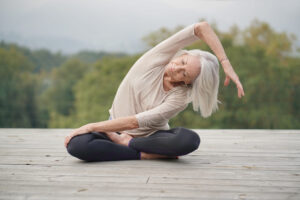Although arthritis treatment plans may include medication to alleviate discomfort and reduce swelling, a bespoke exercise program may also be recommended by a physiotherapist. Some people may worry that exercise will increase their pain or damage their joints. But joints are designed to move, and inactivity can create more problems. Let’s explore the benefits of exercise for those living with arthritis and how to use it help you continue living a happy, active life.
Benefits of regular exercise to people living with arthritis
Physiotherapists often recommend three different types of exercise in a program tailored for an individual with arthritis; range of motion, strength, balance and endurance or fitness.
The key benefits include:
- maintaining normal joint movement
- increasing muscle flexibility and strength
- lowering or maintain weight to reduce pressure on joints
- keeping bone and cartilage tissue strong and healthy
- improving endurance and cardiovascular fitness.
How to successfully and safely use exercise to help your arthritis
Keeping motivated can be tricky when first starting out with your exercise routine. Here’s how you can increase your motivation and therefore likelihood of long-term success:
- do an activity that you enjoy
- set realistic goals. But remember that these may need to change if your condition and symptoms change over time
- put regular sessions in the calendar so it becomes a habit
- get active with a friend or family member to make it a fun, social activity
- reward yourself for every success or milestone met.
When first starting out, it’s a good idea to take it easy and build it up over time to allow your joints to get used to it. Too much too soon can cause pain and injury and can put you off.
To build up your activity, try to increase the below gradually over time:
- frequency – how often you do it
- duration – the length of time you spend exercising
- intensity – how hard you try.
Do I need to see a doctor or physiotherapist?
You don’t always need to see a doctor or physiotherapist to get started with exercise. As long as you follow guidance to take things slow and steady, and listen to your body if anything feels uncomfortable. If you have any pain or worries, or if you’re struggling for motivation, it may be beneficial to consult a professional.
Some conditions may require a referral to a physiotherapist. They will recommend a tailored exercise plan to help with your specific issue.
Types of exercise to improve arthritis symptoms
Range of motion exercises (stretching or flexibility)
Many people living with arthritis tend to bend the affected joint(s), and hold them in this position because it feels more comfortable to do so. However, this relief is usually temporary – keeping a joint in the same position for too long can permanently limit mobility. Range-of-motion exercises – also called stretching or flexibility exercises – help improve and maintain joint function by increasing and preserving mobility and flexibility of the joint.
Range of motion exercises involve straightening and bending the affected joint(s), one at a time, in a controlled manner. You should straighten them as far as they will comfortably go.
With range of motion exercise, your joints are stretched progressively further each time until the normal range of motion is achieved. These exercises are also an important form of warm-up and stretching, and should be done before doing any strengthening or endurance exercises, or engaging in any other physical activity.
Tai Chi and Yoga are great activities to practice range of motion exercises in a safe and fun way. Versus Arthritis, a merger of Arthritis Care and Arthritis Research UK, have prepared a helpful hub full of simple exercises you can do at home.
Strength exercises
Strengthening exercises are important to keep the muscle and soft tissue around your joints strong. Developing strength helps to stabilise your joints and reduce pain. Your muscles can get weaker very quickly after just a few days of reduced activity, so it is recommended that you try to keep it up.
In simplest terms, strengthening involves doing exercises against resistance. This can include everyday activities such as standing up from a chair or sofa because you’re working against the resistance of gravity.
To safely do strength exercises, you should slowly build up the frequency of sessions (up to at least two days per week) and number of repetitions that you do. After a session, your muscles should feel tired and like you have worked them. However, they should not feel painful.
If you are experiencing hot or swollen joints because of your arthritis, it may be a good idea to focus instead on stretching exercises until the swelling goes down.
Pilates, including mat, equipment or reformer-based classes, can be a great way to perform these exercises. Alternatively, you could even use everyday objects around the house with a resistance band. The Versus Arthritis exercise hub should give you a few ideas.
Balance exercises
Regular balance exercises should be carried out at least twice per week and they become particularly important as we get older to reduce the risk of falls. Falls can be dangerous, particularly to those with arthritis, due to the potential impact on bones and joints.
You can carry out simple balance exercises at home, and activities like playing bowls, tai chi or dancing are all great ways to work it into your weekly routine.
Fitness exercises
Fitness exercises (sometimes known as aerobic or endurance exercises) are important for everyone to stay healthy and maintain a healthy weight.
Fitness exercises improve the strength, balance and range of movement of your joints simultaneously, along with the health of your heart and lungs.
Any exercise that elevates your heart rate and gets you breathing more quickly will do this. Walking, cycling or a gym session can be great ways to work out. For a low-impact alternative, try swimming or aerobic exercise classes carried out in a swimming pool.
—
Got questions or concerns?
Don’t forget, if you experience any pain or don’t know where to start, you can always consult with your GP, a First Contact Practitioner or a private physiotherapist. In some areas of England, you can self-refer to see an NHS physiotherapist. Visit our NHS page for details.





